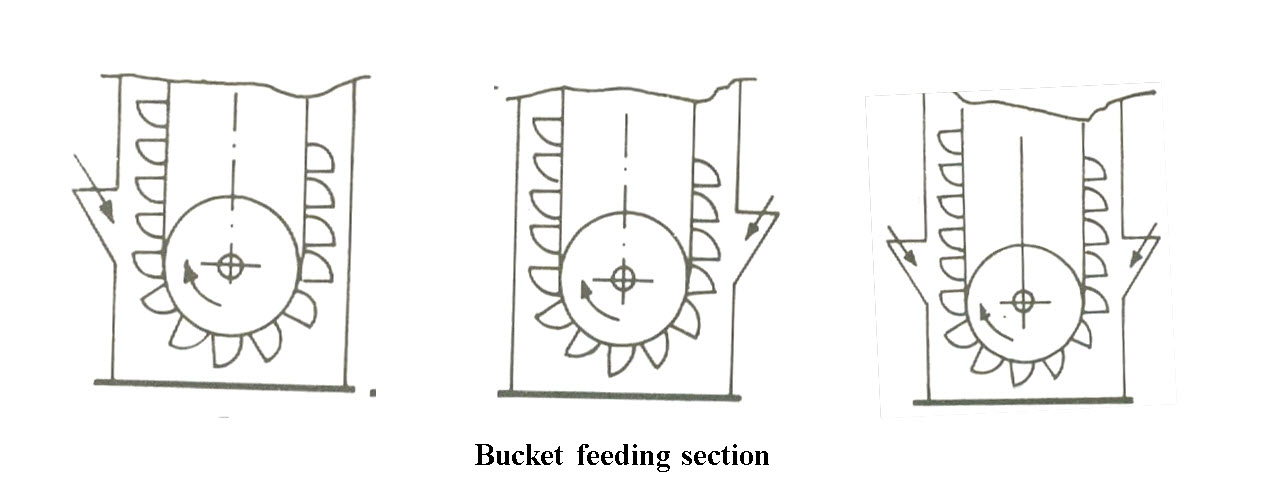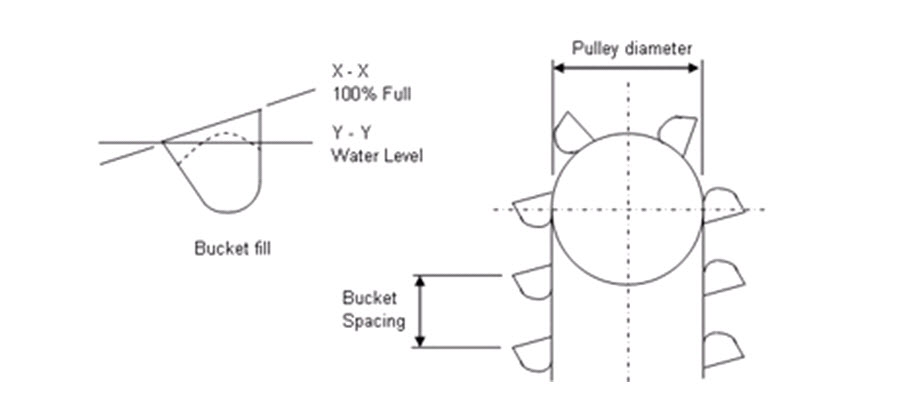Site pages
Current course
Participants
General
Module- 1 Scope and importance of food processing....
Module- 2 Processing of farm crops; cereals, pulse...
Module- 3 Processing of animal products
Module- 4 Principal of size reduction, grain shape...
Module- 5 Theory of mixing, types of mixtures for ...
Module- 6 Theory of separation, size and un sized ...
Module- 7 Theory of filtration, study of different...
Module- 8 Scope & importance of material handl...
Lesson 31. Bucket Elevator
A bucket elevator consists of buckets attached to a chain or belt that revolves around two pulleys one at top and the other at bottom. The bucket elevator is a very efficient deivce for the vertical conveyance of bulk grains. The elevator can lift the materials between few meters to more than 50 m. Capacities of bucket elevators may very from 2 to 1000 t/h. Bucket elevators are broadly classified into two general types;
1) spaced bucket elecators and
2) continuous bucket elevators.
The above two types are further sub divided into various classed.
The spaced bucket elevators are further classified as;
a) centrifugal discharge elecators
b) positive-discharge elevators
c) marine leg elevators and
d) high-speed elevators.
The continuous bucket elevators are classified as;
a) super capacity bucket elevators and
b) internal-discharge bucket elevators.
The spaced-bucket centricugal discharge type is most commonly used for elevating the grains. Bucket elevators with belts are used in food industries for vertical converyance of grains, its derivatives and flours. Bucket elevators have high capacities and it is a fairly cheap means of vertical conveyance. It requires limited horizontal space and the operation space and the operation of conveying is enclosed in housing, thus it is dust free and fairly quite.
In a bucket elevator, the conveyor belt with buckets runs over pulleys at the upper and lower ends. The top pulley is driven pulley while the lower pulley is return and tension pulley. Buckets are usually made of steel or plastic and are bolted onto the belt. The bucktes may be enclosed in a single housing called leg or two legs. The return leg may be located at some distance from the elevator leg. The housing or legs are also made of steel are welded or boltyed together and are dust tight. The curved hood is designed for proper centrifugal discharge of the grains. The boot can be loaded from the front or back or both . The product flow is discharged either by means of gravity or centrifugal force.
The bucket elevator’s capacity mainly depends on bucket size, conveying speed, bucket design and spacing, the way of loading and unloading, the bucket and the charactesistic of bulk material. Bucket elevators with a belt carrier can be used at fairly high speeds of 2.5 to 4 m/s. The speed of the belt depends upon the head pulley speed. A properly deisgned bucket ele3vator deriven at the correct speed will make a clean discharge. If the belt speed uis too low, the discharge of the grains becomes more difficult, wioth too high speed the buckets are not fed wel.
In elevating of grains the discharge from bucket elevators is a combination of centrifugal and gravitational discharge. Part of the bucket conetnts is projected by the centrifugal force, the rest flows out by gravity.
The bucket elevator’s capacity can be calculated by the follwoing equation.
Elevator capacity,
t/hr =

The main parts of a bucket elevator are;
- elevator head and boot section
- elevator legs
- belts for bucket elevator and
- buckets.
Head and Boot Section
The head section should be of the proper shape and size with smooth counters. The discharge side of the head should be shaped so that material thrown from the buckets may not deflect into the down leg. When the product is not thrown well clear of the buckets into the dischage chute, it will fall in the down leg. This is called as “back logging”. The back logged material has to be re-elevated, thus it reduces the capacity of the elevator. To avoid back-logging, an adjustable cut off plate is provided close to the lip of bucket.

Bucket elvators boots should be of bolted assembly to allow for proper maintanance and replacement of pulley, shaft and other accessoris. In the boot section, the loading chite should be located at such point that the pick-up of the product by the buckets takes place above the centre line of the return pulley.

Elevator legs
The up and down moving string of buckets in bucket elevators are enclosed in elevator legs. The elevator legs stop the emission of dust. These legs are constructed as all welded, bolted or riveted. The strings of up and down moving buckets can either run in a common leg or in separate legs. With double legs, a balanced pressure can be obtained by ducts connecting on different levels of the upgoing and downgoing trunk. Service and inspection openings are needed as it requires adequate maintenance.
Elevator Belts
In a normal operation of the bucket elevator, the loads exerted by the elevator height, product weight, weight of bucket belt and idle tension and the digging resistance are taken by the belt. The bucket elevatyor belt has no support between the drive and the return pulleys, therefore, cross stiffness of belt is very important. Most conveyoor belts consist of synthetic fibres like polysters and ploymide and built up with synthetic rubber or PVC. To increse tensile strength of belt, several layers of fibres are put together to build a carcass. Such carcass is able to withstand very high tensile forces with minimum of stretch.
During continuous operation, elevator belts are susceptible to various mechanical stresse3s which may cause wear. The friction between drive pully and the belt causes wear in the underside of the belt. The back faling product is caught and crushed between the belt and return pulley. Extra forces are also exerted on the belt by rigid buckets while psssing over the head pulley.
Buckets
As per the requirements, buckets are made of different materials and come in veroius shapes and sized. The shape of the bucket is very important for filling and discharge. Digging in of buckets in the elevator boot and the centrifugal discharge at the elevator head influence the shape of buckets.

For centrifugal discharge the resultant of product weight and the centrifugal force should preferably be directed towards the lip of the bucket. The buckets should have a wide open mouth for digging nd discharging the product. The conveuying capacity of the elevator also depends upon the number of buckets per metre belt length.
The capacity and discharge of each bucket is influenced by the previous bucket, hence the distance betwen two successive buckets is impornttant. Therefore, comprosime between the following factors is required 1) the design and content of the bucjkets, 2) the shortest distance between cussessive buckets wothout any mutual influence, 3) for centrifugal disrhagte the appropriate belt speed and diameter of drive pulley. In general, the spacing would be from 2.0 to 3.0 times the projected width of bucket.